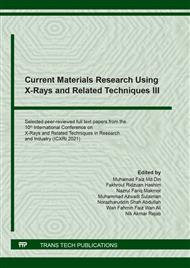p.578
p.585
p.592
p.598
p.605
p.612
p.621
p.626
p.633
Tropical Climate Adaptation via Biomimicry and Surface Functionalization for Electronic Circuitry
Abstract:
Surface functionalization has diverse applications from tropicalization, superhydrophobicity to chemical bonding and biomolecular applications. Tropical climate adaptability is necessary in order to successfully carry out the equipment’s functionality in extreme climate. Temperature gradient can lead to internal damage and humidity also leads to the surface’s degradation, thus lead to circuits’ shortcuts. Hence this research aimed to fabricate and characterize polydimethylsiloxane (PDMS) based biomimicry and surface functionalization for hydrophobic, fungus free and stable layer against tropical climate. Another nanoparticle that needs to be used to optimize the required criteria is polytetrafluoroethylene (PTFE). Varying the ratio of PDMS/PTFE mixture affects the resulting performance. The composite was layered onto taro leaves using soft-lithography technique. Several of the conventional method limitations were addressed such as water contact angle (WCA) and light transmittance. The overall average WCA of a PDMS/PTFE template obtained was between 92° until 108° whereas for a negatively replicated PDMS/PTFE template was between 121° until 131°. The plain PDMS template shows the average transmittance of 62.28% whereas the PDMS/PTFE template shows the average of less than 7.49% transmittance. The negatively replicated leaf PDMS/PTFE template shows the average transmittance percentage of 15.772% and a minimum of less than 2%. The obtained WCA results had proven that the soft-lithography technique is able to increase the surface wettability of equipment.
Info:
Periodical:
Pages:
605-611
Citation:
Online since:
January 2022
Authors:
Price:
Сopyright:
© 2022 Trans Tech Publications Ltd. All Rights Reserved
Share:
Citation:


